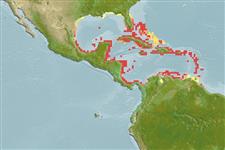Environment: milieu / climate zone / depth range / distribution range
Ekologi
marina revassocierade; ej vandrande; djupintervall 0 - 3 m (Ref. 7247). Tropical; 32°N - 8°N, 98°W - 59°W
Western Central Atlantic: Florida, Gulf of Mexico, Caribbean Sea and along the coast of central America to Panama and Venezuela. Also known from the Bahamas and the Antilles.
Size / Vikt / Age
Maturity: Lm ? range ? - ? cm
Max length : 15.0 cm TL hane/ej könsbestämd; (Ref. 26340)
Short description
Bestämningsnycklar | Morfologi | Morfometri
Taggstrålar i ryggfenan (totalt) : 12; Mjukstrålar i ryggfenan (totalt) : 14 - 17; Taggstrålar i analfenan: 2; Mjukstrålar i analfenan: 13 - 15. Juveniles are reddish orange above, with small bright blue spots on forehead and dark spots at upper pectoral fin base, dorsal fin, and caudal peduncle; colors disappear as fish grows larger (Ref. 26938). Adults dark gray to blackish with vertical black lines on body; a black spot, sometimes diffuse, at upper base of pectoral fins which are pale; other fins dark (Ref. 13442).
Adults inhabit rocky shores exposed to wave action. Often in tide pools. Feed primarily on algae and detritus. Territorial and pugnacious. Generally common (Ref. 9710). Oviparous, distinct pairing during breeding (Ref. 205). Eggs are demersal and adhere to the substrate (Ref. 205). Males guard and aerate the eggs (Ref. 205). Taken incidentally in traps and small-meshed beach nets (Ref. 5217).
Life cycle and mating behavior
Könsmognad | Reproduktion | Lek | Ägg | Fecundity | Larver
Oviparous, distinct pairing during breeding (Ref. 205). Eggs are demersal and adhere to the substrate (Ref. 205). Males guard and aerate the eggs (Ref. 205).
Allen, G.R., 1991. Damselfishes of the world. Mergus Publishers, Melle, Germany. 271 p. (Ref. 7247)
IUCN Red List Status (Ref. 130435: Version 2024-1)
Threat to humans
Harmless
Human uses
Fiskeri: kommersiell; Akvarium: Kommersiell
Verktyg
Special reports
Download XML
Internet-källor
Estimates based on models
Preferred temperature (Ref.
123201): 26.2 - 28.3, mean 27.5 °C (based on 449 cells).
Phylogenetic diversity index (Ref.
82804): PD
50 = 0.5000 [Uniqueness, from 0.5 = low to 2.0 = high].
Bayesian length-weight: a=0.02089 (0.00953 - 0.04582), b=2.98 (2.80 - 3.16), in cm total length, based on LWR estimates for this Genus-body shape (Ref.
93245).
Trofisk nivå (Ref.
69278): 2.5 ±0.1 se; based on diet studies.
Resiliens (Ref.
120179): Hög, lägsta populationsfördubblingstid mindre än 15 månader (Preliminary K or Fecundity.).
Fishing Vulnerability (Ref.
59153): Low vulnerability (10 of 100).
Nutrients (Ref.
124155): Calcium = 105 [52, 172] mg/100g; Iron = 0.724 [0.421, 1.239] mg/100g; Protein = 18.3 [17.1, 19.5] %; Omega3 = 0.0847 [, ] g/100g; Selenium = 16.2 [8.4, 32.9] μg/100g; VitaminA = 79.7 [20.8, 291.8] μg/100g; Zinc = 1.79 [1.18, 2.71] mg/100g (wet weight);
